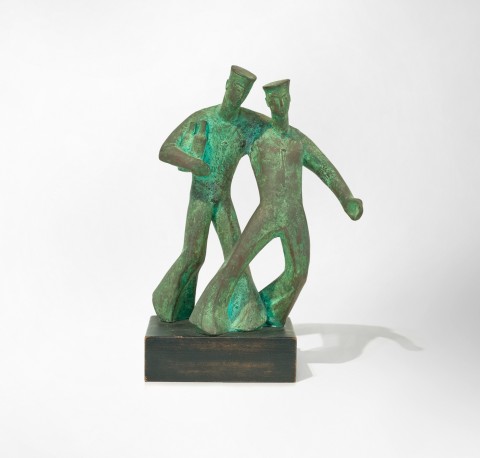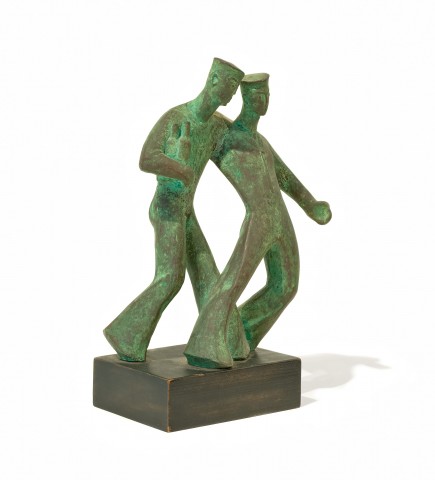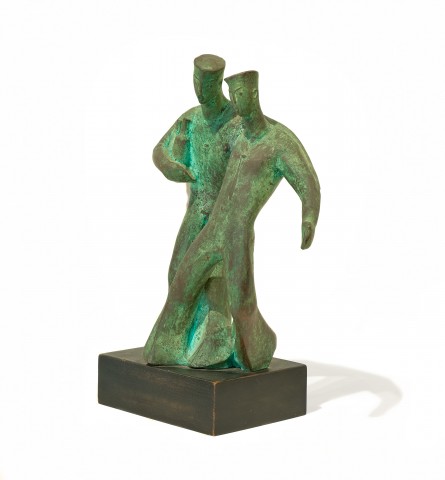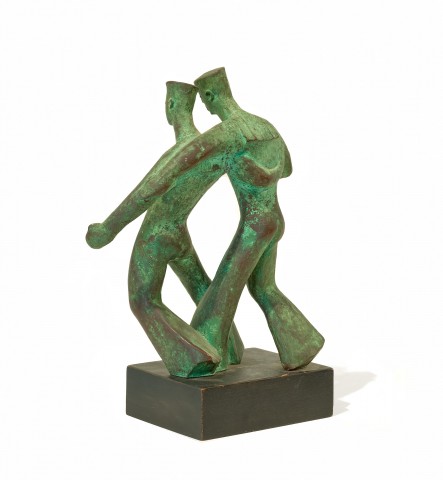TWO JOLLY SAILORMEN, c.1942
DAPHNE MAYO
copper with green patina
29.0 x 24.0 x 12.5 cm
Dr Christine Rivett, Sydney, by 1951
Peter Morton, Sydney
Private collection, Sydney, acquired in the 1980s
Society of Artists, Annual Exhibition, Education Department’s Art Gallery, Sydney, 2 – 24 September 1942, cat. 219 (as ‘Two Jolly Sailormen’ (bronze) [sic])
Three Sculptors' Exhibition (with Arthur Fleischman and Lyndon Dadswell), David Jones' Art Gallery, Sydney, 18 July 1946 (as ‘Jolly Sailors’ ceramic version)
Follow the Flag, Australian Artists and War 1914 – 45, National Gallery of Victoria, Melbourne, 24 April – 16 August 2015 (ceramic version)
Reality in flames: Modern Australian Art & The Second World War, An Australian War Memorial travelling exhibition, opened at S.H. Ervin Gallery, Sydney, March – April 2014, and toured to regional galleries throughout New South Wales and Queensland, and Australian War Memorial, Canberra, 3 July 2015 – 7 September 2016
Society of Artists Book 1942, Ure Smith Pty Ltd, Sydney, 1942, p. 68
Rees, L., ‘Daphne Mayo’, Australian Present Day Art, Ure Smith, Sydney, 1943, pp. 6, 66, 68 (illus.)
‘Sculpture exhibit commands respect’, Australian National Journal, August 1946, pp. 47 – 48
McKay, J., Daphne Mayo Sculptor (Thesis), University of Sydney, Sydney, 1981, V.1, pp. 196, 212
McKay, J., Daphne Mayo Sculptor (Catalogue of Sculpture), University of Queensland, Brisbane, 1990, V.2, cat. 109 A (illus., np)
Grishin, S., ‘A bold look at images of wartime’, The Canberra Times, Canberra, 9 August 1994, p. 16
Heywood, W., (curator), Reality in flames: Modern Australian Art & The Second World War, Australian War Memorial, Canberra, 2014, p. 96 (illus., ceramic version)
Two jolly sailormen, 1944, glazed earthenware, University of Queensland Art Collection, Brisbane
Two jolly sailormen, 1944, glazed earthenware, Australian War Memorial, Canberra
Two jolly sailormen, 1944, glazed earthenware, Art Gallery of Ballarat, Victoria
In April 1942, the invasion of Australia seemed imminent. Singapore had fallen, Darwin bombed, and Japanese forces had invaded New Guinea. Under the command of General Douglas MacArthur, large numbers of American troops began to arrive in Australia, with bases established down the east coast. Suddenly Sydney, Melbourne and Brisbane were awash with Yankee soldiers and sailors.
Daphne Mayo sailormen.jpg
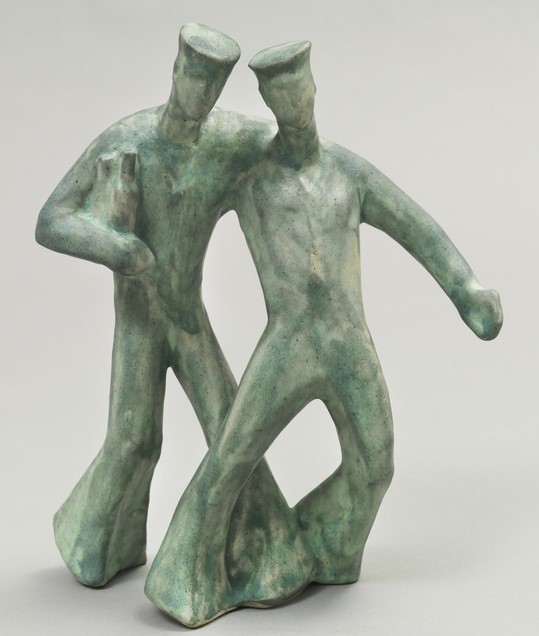
Daphne Mayo
Two jolly sailormen, c.1944
glazed ceramic, 27 x 22.2 x 10.5 cm
Australian War Memorial, Canberra
Formerly based in Brisbane, sculptor Daphne Mayo moved back to Sydney when the War began, setting up her studio in lower George Street, which was then something of an artistic hub. Mayo felt like a change of pace. She had more than proved her credentials as an artist, winning many scholarships including to the Royal Academy in London and completing several large and important public commissions.1
The move marked a change in focus for Mayo, giving her the freedom to develop smaller works and to experiment with different materials, including ceramic and wood. She exhibited more often and enjoyed the larger artistic community that Sydney offered. Always ‘addicted to scribbling’ (as she once confessed to archivist Hazel de Berg),2 Mayo valued the opportunity to move away from the classical that monumental design demanded to a more naturalistic style, works such as Fat man, 1940 (Art Gallery of New South Wales) and this perfect small work, Two Jolly Sailormen, c.1942 demonstrate this.
Mayo.JPG
Daphne Mayo working on the Brisbane City Hall tympanum
c.1930
University of Queensland, Fryer Library, Brisbane
The two sailors are distinctly American. From their flat-topped caps to their flared pants, we can instantly see we are not looking at two British sailors who mostly wore shorts with long socks during World War II. There is also a cocky swagger to the work that encapsulates their Yankeedom. The brilliant simplicity of the design belies its geometric complexity. Triangles and trapezoidal spaces of different shapes and sizes sit between the men’s heads, torsos and legs. Overlayed are details of such subtlety that they almost constitute a short story: after many hours of carousing the two men are heading off somewhere to continue their drinking, the more sober man clutching two bottles of beer and propping his friend up at the same time. He is ranting, perhaps about being thrown out of the hotel at 6pm, an early closing time that dismayed visiting overseas forces.3 Where will they go? he angrily slurs to his mate. The second sailor is thinking, his mind a blur. What? Where? His left leg buckles in a perilous dip while his right leg, thrown out drunkenly into his friend’s path, seems doomed to end in a fall for both.
Mayo was appointed MBE in 1959 and, after joining the Board of the Queensland Art Gallery in 1960, returned to live in Brisbane. By the time of her death on 31 July 1982, she was recognised as the most important Australian female sculptor of her time.
1. For all biographical material see: McKay, J., ‘Mayo, Lilian Daphne (1895 – 1982)’, in Australian Dictionary of Biography, National Centre of Biography, Australian National University, 2012 at https://adb.anu.edu.au/biography/mayo-lilian-daphne-14954/text26143 (accessed March 2023)
2. Daphne Mayo Speaks/Daphne Mayo: Let There Be Sculpture, Queensland Art Gallery I Gallery of Modern Art at https://www.youtube.com/watch?v=trFd_L9cDPs (accessed March 2023)
3. This did not change until the mid-1960s.
DR CANDICE BRUCE
